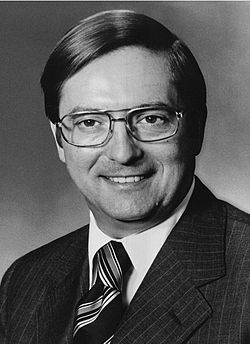
A United States under secretary of commerce is one of several positions in the United States Department of Commerce, serving under the United States Secretary of Commerce.

A United States under secretary of commerce is one of several positions in the United States Department of Commerce, serving under the United States Secretary of Commerce.
In June 1939, Edward J. Noble was appointed the first under secretary of commerce [1] a role created especially for him by President Franklin D. Roosevelt that had a salary of $10,000 per year. [2] He was succeeded by Wayne Chatfield-Taylor, the former Assistant Secretary of the Treasury who later served as president of the Export-Import Bank. [3] The role was later held by various prominent people, including Cornelius Vanderbilt Whitney (under President Truman), [4] and Franklin D. Roosevelt Jr. (under Presidents Kennedy and Johnson), when the job had a salary of $21,000 per year. [5] [6] On December 13, 1979, President Jimmy Carter replaced the role of under secretary, which was then held by Luther H. Hodges Jr., with United States Deputy Secretary of Commerce, and Hodges became the first holder. [7]
In 1950, President Truman proposed transferring the functions of the Maritime Commission to the Department of Commerce to be led by the newly created Under Secretary of Commerce for Transportation. [8] Truman had created Civil Aeronautics Administration and transferred the Bureau of Public Roads within the department the previous year. In 1966, all transportation activities of Commerce were moved to the newly established United States Department of Transportation, which was led by former Under Secretary Alan Stephenson Boyd. [9]
The under secretary positions are: [10]
| Image | Name [12] | Term began | Term ended | President(s) served under |
|---|---|---|---|---|
 | Edward J. Noble | 1939 | 1940 | Franklin D. Roosevelt |
 | Wayne Chatfield-Taylor | 1940 | 1945 | |
| Alfred Schindler | 1945 | 1946 | Harry S. Truman | |
 | William Chapman Foster | 1946 [13] [14] | 1948 [15] | |
 | Charles W. Sawyer | 1948 | 1949 | |
 | Cornelius Vanderbilt Whitney | 1949 [16] | 1950 | |
 | W. Walter Williams | 1952 [17] | 1958 | Dwight D. Eisenhower |
| Philip A. Ray | 1959 [18] | 1961 | ||
| Edward Gudeman | 1961 [19] | 1963 [20] | John F. Kennedy | |
 | Franklin D. Roosevelt Jr. | 1963 | 1965 | John F. Kennedy Lyndon B. Johnson |
 | LeRoy Collins | 1965 | 1966 | Lyndon B. Johnson |
| John Herbert Hollomon Jr. | 1967 [21] | 1967 | ||
| Howard J. Samuels | 1967 | 1969 | ||
| Joseph W. Bartlett | 1968 [22] | 1969 | ||
| Rocco C. Siciliano | 1969 [23] | 1971 [24] [25] | Richard Nixon | |
 | James Thomas Lynn | 1971 [26] | 1973 | |
| John K. Tabor | 1973 [27] | 1975 [28] | Gerald Ford | |
 | James Baker | 1975 [29] | 1976 | |
| Edward O. Vetter | 1976 [30] | 1977 | ||
| Sidney Harman | 1977 | 1978 | Jimmy Carter | |
| Luther H. Hodges Jr. | 1978 [31] | 1979 |
| Image | Name [12] | Term began | Term ended | President(s) served under |
|---|---|---|---|---|
 | Philip B. Fleming | 1950 [32] | 1951 [33] | Harry S. Truman |
| Delos W. Rentzel | 1951 [33] | 1951 [34] | ||
| Jack Garrett Scott | 1952 [35] [36] | 1953 [37] | ||
| Robert B. Murray Jr. | 1953 [38] | 1955 | Dwight D. Eisenhower | |
| Louis S. Rothschild | 1955 [39] | 1958 [12] | ||
 | John J. Allen Jr. | 1959 | 1961 | |
| Clarence D. Martin Jr. | 1961 | 1965 [40] | John F. Kennedy Lyndon B. Johnson | |
 | Alan Stephenson Boyd | 1965 [41] | 1966 | Lyndon B. Johnson |